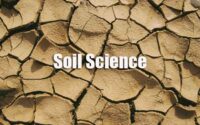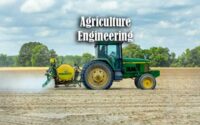Soil Science Quiz
1. Sediment yield is the :-
(1) Total soil loss from an area
(2) Product of gross erosion and delivery ratio
(3) Both (1) and (2)
(4) None
2. Removal of thin and fairly uniform layer of the soil from the land surface by run off water is called as :
(1) Torrent erosion
(2) Sheet erosion
(3) Rill eroded
(4) Glacial erosion
3. Loose rock fill dams are preferred for gully control, where :
(1) Gullies are of greater depth
(2) Gullies are of lesser depth
(3) Tones are readily available
(4) None of above
4. What type of material is most likely to be transported as suspended load?
(1) Clay
(2) Silt
(3) Sand
(4) Depends on the “energy” of the stream
5. Why is soil erosion more common in areas that lack adequate vegetation?
(1) Because gravity pulls on the plants and increases erosion
(2) Because plant roots help keep the soil in place
(3) Because soil erosion is stopped by reduced vegetation
(4) Because the lack of adequate vegetation affects the soil pressure and erosion rate
6. In India the current rate of soil loss for agricultural land is :
(1) 6-12 t/ha/ year
(2) 7.5-15 t/ha/ year
(3) 20-30 t/ha/ year
(4) 80-100 t/ha/ year
7. Design of vegetated waterways is based upon :
(1) Manning’s formula
(2) Cook’s method
(3) Thiessen method
(4) Universal soil loss equation
8. The minimum wind velocity required to initiate movement of soil particles is known as :
(1) Critical velocity
(2) Threshold velocity
(3) Dynamic threshold velocity
(4) Intrinsic velocity
9. Contour bunding is used in slopes having slopes less than about :
(1) 6%
(2) 9%
(3) 12%
(4) 15%
10. Sediment is transported in channels by :
(1) Saltation
(2) Suspension
(3) Bed load movement
(4) All the above three factor
11. Sloping inward bench terraces are effective in :
(1) Heavy rainfall areas
(2) Medium rainfall areas
(3) Low rainfall areas
(4) Drought prone area
12. The ratio of the diameter of a circle with same area as the basin to the maximum basin length is called as :
(1) Circulatory ratio
(2) Elongation ratio
(3) Compactness factor
(4) Stream length ratio
13. The line of seepage in earthen embankment is also called –
(1) Phreatic line
(2) Lower most flow line
(3) Water pressure line
(4) Runoff line
14. In the rational formula Q = 0.0028 CIA, I is intensity of rainfall in –
(1) mm/hr
(2) cm/hr
(3) m/hr
(4) km/hr
15. Pick up the correct statement :-
(1) Sloping outwards bench terraces are effective in low rainfall areas.
(2) Sloping inward bench terraces are effective in low rainfall areas.
(3) Table top bench terraces are effective in low rainfall area.
(4) Broad base terraces are constructed in small and scattered land holdings.
16. Which of the following statement is correct ?
(1) The purpose of the wing wall is to prevent seepage under the structure.
(2) Wing wall is constructed to prevent swirling effect of water.
(3) Chute spillway provides temporary storage on upstream side.
(4) Wing wall is constructed at the angle of 60° from side wall.
17. Which of erosion is extremely harmful for the land ?
(1) Raindrop erosion
(2) Sheet erosion
(3) Rill erosion
(4) Gully erosion
18. Area lost due to contour bunding is given by :
(1) 0.305(s / (a + b))
(2) s x b/ VI
(3) 100s x b/ VI
(4) Ws x h/ 2
19. In the stream having depth upto 3 m, the suspended sediment is measured at the depth of :
(1) 0.6d
(2) 0.8d
(3) 1.5d
(4) 0.2d
20. Which of the following outlet is not made in drop spillway ?
(1) Straight
(2) Flared
(3) Curved
(4) Box
| MCQs | Quiz |
| GK | Questions and Answers |
21. Contour bunding is to be done in a land having 4% gradient. If horizontal interval of the bund is 100 m, the vertical interval between the bunds will be :
(1) 25 m
(2) 0.25 m
(3) 4 m
(4) 2.5 m
22. The woven wire dams are backed with well tamped earth fill slope of atleast :
(1) 4:1
(2) 3:1
(3) 2:1
(4) 1:1
23. To construct a loose rock dam, a trench is made which forms the base of dam on which the stones are laid in rows. The approximate depth of the trench should be :
(1) 10 cm
(2) 30 cm
(3) 50 cm
(4) 70 om
24. In building the slab dams the posts at an interval of 1.2 m are set in row across the gully to a depth of about :
(1) 30 cm
(2) 50 cm
(3) 70 cm
(4) 100 cm
25. The ability of rock or soil to allow water to flow through it is called as:
(1) Non-point pollution
(2) Irrigation
(3) Permeability
(4) Water conservation
26. Most groundwater withdrawn in the world is used for :
(1) Industry
(2) Irrigation
(3) Drinking water
(4) Swimming pools
27. With respect to the Earth’s land surface, which of the following expressions is correct ?
(1) Precipitation = evaporation — runoff
(2) Precipitation = runoff — evaporation
(3) Precipitation = evaporation + runoff
(4) Precipitation = evaporation < runoff
28. What is the best method for calculating excess rainfall and runoff ?
(1) Hortonian
(2) SCS Curve Number
(3) Green and Ampt
(4) Snyder Unit Hydrograph
29. The boundary between the saturated zone and the unsaturated zone is called the :
(1) Water table
(2) Aquifer
(3) Aquiline
(4) Porosity
30. Excessive pumping in relation to groundwater well can cause –
(1) The water table to decline
(2) A cone of depression
(3) The well to go dry
(4) All of these
31. Which of the following is the term given to water moving horizontally through soil eventually reaching river ?
(1) Percolation
(2) Ground flow
(3) Interception
(4) Through flow
32. The evaporation pan coefficient of class-A pan is generally taken as :
(1) 7.0
(2) 0.70
(3) 0.07
(4) 1.2
33. What is the difference between the saturated and the unsaturated zones of ground water ?
(1) The saturated zone has a higher porosity than the unsaturated zone
(2) The saturated zone has a lower porosity than the unsaturated zone
(3) The pore spaces in the saturated zone are completely full of water. The pore spaces in the unsaturated zone are not completely full of water.
(4) The pore spaces in the saturated zone are not completely full of water; the pore spaces in the unsaturated zone are completely full of water
34. Rainfall intensity is measured by –
(1) A hygrograph.
(2) Evaporimeter
(3) Simple rain gauge
(4) Automatic raingauge
35. The maximum tolerance in a 20 m chain is :
(1) +2 mm
(2) +3 mm
(3) +5 mm
(4) +8 mm
36. Height of instrument method of leveling is :
(1) More accurate than rise and fall method
(2) Less accurate than rise and fall method
(3) Quicker and less tedious for large number of intermediate sights
(4) None of the above
37. Size of Theodolite is specified by : .
(1) The length of telescope
(2) The diameter of vertical circle
(3) The diameter of level plate
(4) The diameter of upper plate
38. Electronic Theodolites of various ranges in which measured angles are displayed originally on display board are based on which one of the following ?
(1) Special optical technology
(2) Introduction of Microprocessor technology
(3) Electro-optical technology
(4) Special gearing
39. Surveys which depict the natural features of a country are known as :
(1) Cadastral surveys
(2) Engineering surveys
(3) Topographic surveys
(4) Geological surveys
40. Perpendicular offsets may be taken by setting the right angle in the ratio –
(1) 3:4:5
(2) 2:4:9
(3) 3:6:9
(4) 2:4:5
41. A series of closely spaced contour lines represents a ;
(1) Steep slope
(2) Gentle slope
(3) Uniform slope
(4) Plane surface
42. In plane table survey, the operation which must be carried out is :
(1) Resection
(2) Orientation
(3) Radiation
(4) Intersection
43. The U-fork and plumb bob are required for :
(1) Leveling
(2) Orientation
(3) Centering
(4) Marking North line
44. The bench mark (BM) established by the survey of India is known as the;
(1) GTS BM
(2) Arbitrary BM
(3) Permanent BM
(4) Leveled BM
45. The bearing of the line in the direction of the progress of survey is called :
(1) Fore bearing
(2) Back bearing
(3) Reduced level
(4) True bearing
46. For topographical survey of the area vertical angle is taken in :
(1) Chain survey
(2) Plane table survey
(3) Theodolite survey
(4) Dumpy level survey
47. The area on the map is measures by the instrument :
(1) Planimeter
(2) Barometer
(3) Current meter
(4) Pyranometer
48. Pick up the correct statement :
(1) A line joining the point of same elevation is termed as contour line.
(2) A line joining the points of difference reduce level is known is contour line.
(3) A line joining the equal slope is termed as contour line.
(4) A line joining the equal length is termed as contour line.
49. At the valley line the contour line form curve of :
(1) U – shape
(2) V – shape
(3) L – shape
(4) R – shape



